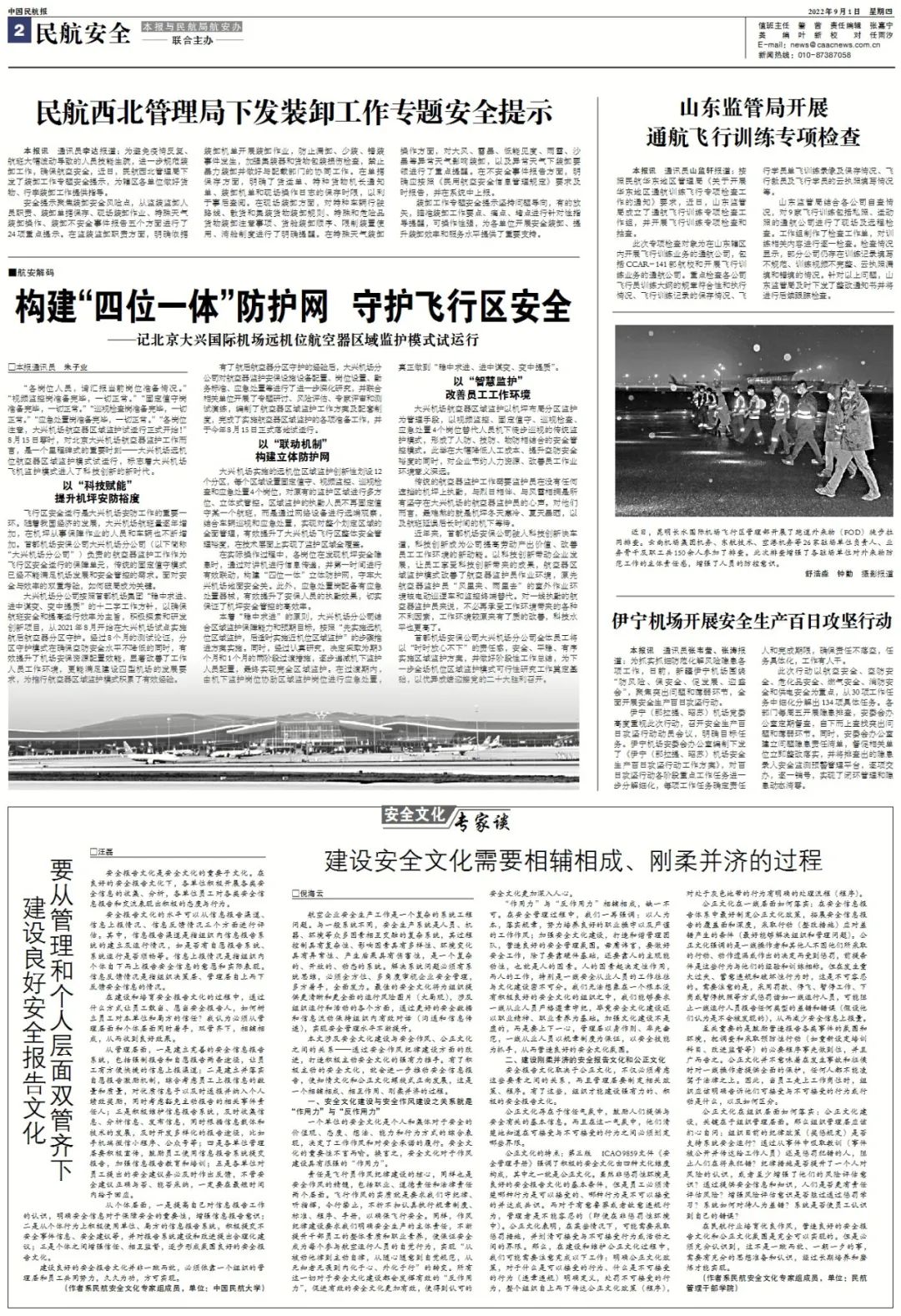Safety and cultural experts talk | Building a safe culture requires the complementary, rigid and soft process
Author:China Civil Aviation News Time:2022.09.01
Aviation enterprise production safety is a complex system engineering problem. Unlike the general system, the safety production system is a complex system that blends with many factors such as personnel, machines, and environment. The process control has complexity, influencing factors with diversity, environmental changes with abnormalities, and harmful consequences. Complex, open, dynamic system. Solve the system problems must have systematic thinking, to review enterprise safety management in all aspects and angles. The best security culture will provide the organization with clearer and more comprehensive risk pictures (view of the overall situation), involving all aspects of organizational operation and activities, and maintain effective dialogue (communication and information in the organization through better security data and information flow. Transmit), the level of safety management has been continuously improved.
This article involves the relationship between the construction of security culture and the style of security and justice -through the improvement of the construction of security style and discipline, to create a strong push for active security culture. With a proactive security culture, it will further promote the report of security information and make the knowledge culture and justive culture spiral development. This is a process of complementary, interaction, and rigidity.
1. The relationship between the construction of safety and cultural construction and the construction of security is "force" and "reaction force
The safety culture of a unit is the comprehensive manifestation of individuals and collectives on the values, attitudes, ideas, ideas, and behavior methods of security, which determines the performance of work style and commitment to security commitments. The importance of safety culture is self -evident. In other words, security culture has a strong "force" for work style construction.
Responsibility is the core of pilot style discipline construction, and it is also the essence of security style, including two levels: occupation, moral responsibility and legal responsibility. The essence of flying style is to require us to keep discipline and listen to commands, and let the trip prohibit, and to implement rules, standards, procedures, and manuals to ensure flight safety. Similarly, the construction of style discipline requires us to clarify the main responsibility of safe production, continuously improve the overall quality and occupational literacy of cadres and employees, so that guaranteeing security becomes a conscious behavior of every participating in aviation operators. The transformation of the transformation of the transformation of the transformation of consciousness and consciousness, from ignorance to internalization and externalization ". All these will play an effective "counter -force" for the construction of security culture, promote effective security culture more effective, and make the recognized security culture more popular.
"Power" and "anti -force force" complement each other, lacking. In the process of security management, we have repeatedly emphasized that people -oriented, implementing rules, and striving to cultivate good professional ethics and rigorous work style; strengthen the construction of security culture, create a harmonious management team, and create a good security management atmosphere. Needless to say, in addition to relying on the foundation of the hardware, to do a good job of safety, it also depends on human subjective initiative, that is, human factor. Human factors play a decisive role, and the work of people's work, especially the front -line security practitioners is often inseparable from cultural construction. We cannot imagine that in an organization that has no positive and good security culture at all, we can ask for the front -line practitioners to strictly follow the rules. After all, the construction of security culture is based on professional spirit and professional literacy. Strengthening cultural construction is not virtual, but to be up and down. Management is based on examples and preferred aspects. The front -line practitioners are guaranteed by the rules and regulations and the safety skills as the starting point, so as to create a good safety cultural atmosphere.
Second, build a rigidity and tender security report culture and justice culture
The security report culture depends on the culture of justice, not only must consider the relationship between these elements, but also the management must formulate relevant policies and procedures. With these, the organization can build a strong and positive security report culture.
A fair culture exists in the atmosphere of trust, and encourages people to provide basic information related to security. And in this atmosphere, they clearly know which boundaries must be determined between acceptable and unacceptable behaviors.
The characteristics of justice: The third edition of the ICAO9859 document "Security Management Manual" emphasizes that a positive security culture is composed of four cultural dimensions, one of which is a fair culture. Although the non -punitive environment is the basic condition of a good security report culture, employees must know which behavior is acceptable and which behavior is unacceptable and reached consensus. For intentional reckless or intentional violations, managers cannot tolerate it (even in non -punitive environments). A fair culture shows that in some cases, punishment measures may be taken, and the boundaries between acceptable and unacceptable behaviors or activities are required. Then, in the process of building and maintaining a fair culture, we may need to pay attention to the following work: clarify the fair cultural policy, which is clearly defined for what is acceptable behavior, what is unacceptable (illegal regulations), and unacceptable punishment behavior The entire organization conveys a fair cultural policy (procedure) from top to bottom, and has a clear processing process (procedure) in the gray zone.
How to implement fair culture at the front line: It is best to formulate a fair cultural policy in the security information report system, expand the coverage and depth of security information reports, and take action (rectification measures) to deal with the conditions of errors (preferably to solve the organization and management issues To. The fair culture emphasizes that the first -line operators and others are punished for not being punished for their actions, omissions or decisions they have taken. The prerequisite is that these actions are commemorative with their experience and training. But when major faults, deliberate violations, and destructive behaviors, this is irreversible. It should be noted that the use of fines, grounding, suspension of work, laid -off, or suspension of licenses such as first -line operators may prevent front -line operators from reporting any types of errors and errors (assuming they think they will not be found), So as to reduce the amount of security information. It is important to encourage the atmosphere and environment of various events, and make the necessary procedures for investigating and taking preventive actions (such as redesigning training subjects, improving supervision, etc.) in advance, and announced it. A fair culture does not mean that the front -line operators provide comprehensive protection when accidents and recruitment, and no one can override the law. Therefore, when employees go to work, the organization should clearly tell them what acceptable and unacceptable behaviors or actions are, and how to distinguish them.
How to implement the organizational level of justice: The key to the construction of justice is the level of organizational management. So the organizational management should ask themselves: Does the current disciplinary policy (reward and punishment regulations) support the safe operation of the system? Or or punishment from the incident (the incident is disclosed and conveyed to the staff) from the incident to prevent people from making mistakes in the future? Does disciplinary measures increase a person's awareness of risks, or at least enhance their awareness of risk assessment? By providing security information and knowledge, are people more responsible for evaluating risks? Is it better to enhance the awareness of risk assessment than through punishment? How does the system treat people wrong? Does the system make employees recognize their mistakes?
It can be achieved by cultivating a good style in the civil aviation industry and creating a good security report culture and a fair cultural atmosphere. However, it must be fully realized that this is not an overnight and overnight thing. It is necessary to have sufficient ideological preparation and understanding. It can be achieved after long -term training and tempering. (Author: Ni Haiyun Civil Aviation Safety Cultural Expert Group member, unit: Civil Aviation Management Cadre College)
This article is published on the 2nd edition of China Civil Aviation September 1, 2022

Edit | Sun Wenjin
School Division | Zhang Tong
Review | Cheng Ling
- END -
The girl watched the sunrise on the mountain early, and lost her feet and fell down the cliff

Recently, many people in Hangzhou stopped many people. In the past few days, touri...
Zhangjiakou: Green empowerment promotes high -quality development
Xinhua News Agency, Shijiazhuang, August 23rd: Zhangjiakou, Hebei: Green empowerment promotes high -quality developmentXinhua News Agency reporter Li Fengshuang, Cao Guo Factory, Gao BoIn the late sum